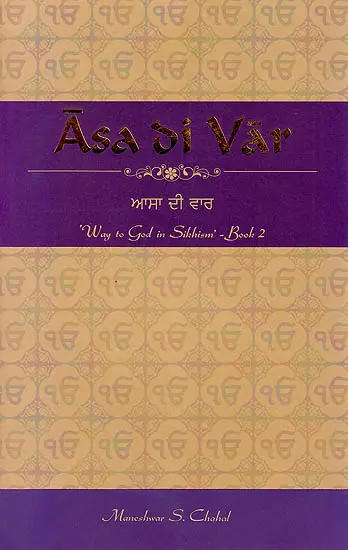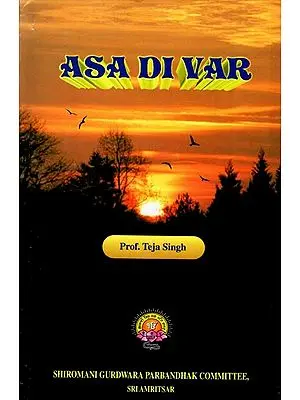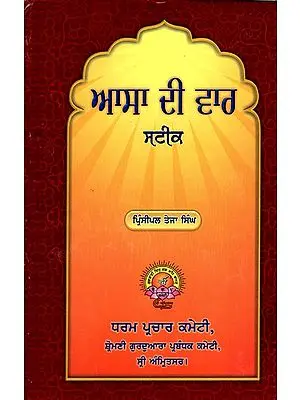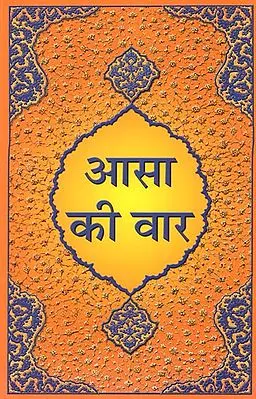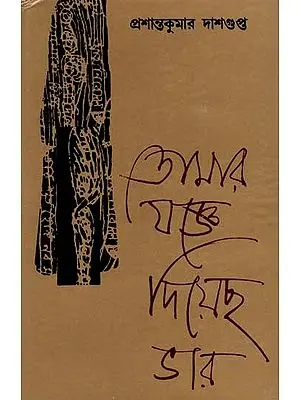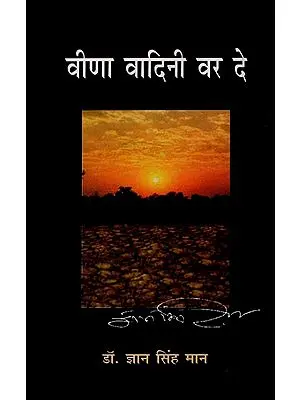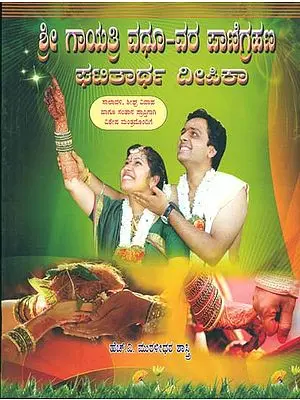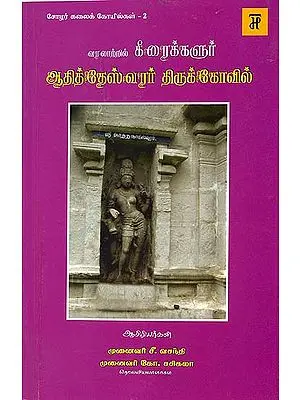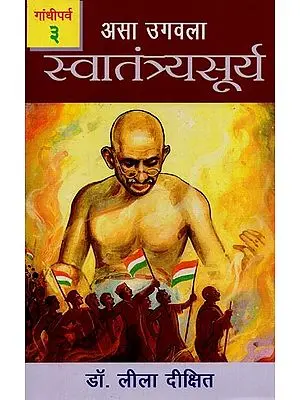Asa Di Var 'Way to God in Sikhism'
| Specifications |
| Publisher: Prakash Books India Pvt. Ltd. | |
| Author: Maneshwar S.C. Chahal | |
| Language: English | |
| Pages: 296 | |
| Cover: Paperback | |
| 8.5 inch X 5.5 inch | |
| Edition: 2009 | |
| ISBN: 9788172342968 | |
| IHL496 | |
| a55_books |
| Delivery and Return Policies |
| Ships in 1-3 days | |
| Returns and Exchanges accepted with 7 days | |
| Free Delivery |
Too often do many of us go through the motions of saying our prayers, morning and evening, without real comprehension. Prayers are, after all, the device through which we approach our Lord. It is vital, therefore, to understand their exact meaning, so that we may speak to Him from our heart, as well as from the mind.
The series, ‘Way to God in Sikhism’, of which this is the second book, explains in simple, modern terminology the real import of the words and the concepts that the Gurus laid down. These concepts are universal and not for the Sikhs alone. All of the mankind can gain from these.
About the Author
Maneshwar S. Chahal is an Engineer by training. He has served in the IAS in Punjab and the Central Government. Besides being the CMD of a Public Sector Bank, he was also a member of the Punjab State Human Rights Commission. A voracious reader all his life, he has also a few short stories to his credit. His consuming passion however has all along been the study of matters spiritual and especially relating to the Sikh religion.
Back of the Book
Published in 2006 by Prakash Books New Delhi
“The author uses abundant imagery, the annotation creates a cascading effect and the prose flows
with each shlok. References intersperse freely with the author’s version of the text and you have
updates on other learned men’s versions of the same phrase. - All in all, this book is a labour of love
and with the paintaking research that has gone into it, the book may stand the test of time.
“Chahal’s objective is to present easily understandable exposition of the lofty spiritual grandeur of
Japaji to the English-knowing people. The author comprehensively covers the subject.”- Beyond a
mere overview, the treatise contains perceptive commentaries and closely reasoned critiques of
various aspects of the Japaji”.- “Idiolectical terms from various languages have been etymologically
explained lucidly.”- “The writing is crisp, research impressive, inferences adroit and conclusions
sound.” - “It is an accomplishment of sound merit and scholarship.” - “Readers would surely benefit
from the refreshing scholarship of Maneshwar Singh Chahal.”
“Very little work has been done on the Banis in English. Maneshwar Singh Chahal’s is a
praiseworthy effort in this direction.”- “The 38 Pauris of the Japji Sahib have been explained very
scientifically and their essence spelt out in easy to understand language. As you read the book you
feel as if you are ascending step by step closer to the Lord. It makes us quite aware that the Japji
Sahib is a unique path to God-realization.”
“The Japji encapsulated into thirty-eight Pauris, has been brilliantly captured by the author.-His
familiarity with the earlier interpretation, combined with his profound insight into the scripture and
keen mental perception animate his expositions with a charm and dignity. - Chahal’s translation and
interpretation of Japji is purely from the viewpoint of a devotee and is free from the baggage of
predilections of scholars, who are bound by the methodologies of one discipline or the other and
who cannot take unbiased and comprehensive view of such a vast subject.-Chahal’s exposition of
Japji Sahib deserves to be ranked as one of the best.”
The Sri Guru Granth Sahib (SGGS) was installed at the Harmandir Sahib in Amritsar, in AD 1604, by the fifth Nanak after collecting and compiling the compositions of the Gurus, and of mystics whose vision of the Lord was as clear and in tune with that of the Gurus. A century later, in AD 1708, the tenth Nanak formally anointed the SGGS as the Guru incarnate for the Sikh nation. It has continued since then to be the only source from where a true Sikh can seek guidance on the path to enlightenment. Richly strewn across its 1430 pages are to be found invaluable pearls of divine wisdom. All it requires of the seeker is diligence, disciplined application of mind and a true desire to be uplifted.
In seeking to approach the SGGS there are a few practical problems the seeker will face. The Gurus while presenting this new philosophy have quite naturally employed the language and the idiom with which their audience would have been familiar. This causes for many readers of today some difficulty in comprehending the true message, made even harder by the use of the verse form for these compositions. Some learned ones have attempted translations of the SGGS and of some important compositions. These however are necessarily brief and leave little space for elaborating on and discussing the terms used. Fortunately for us, learned men of high spiritual attainments, like Bhai Vir Singh and Prof. Sahib Singh, have given their lifetime creating detailed commentaries explaining the terminology and even the most abstruse references. These are quite illuminating, but being in Punjabi again pose some difficulty for the ones not familiar with Gurmukhi, especially those settled outside India. Thus, a pressing need existed for a detailed commentary in English. This humble effort seeks to fill that gap.
While the proper study of any part of the SGGS is fruitful, some compositions explain the philosophy more succinctly, more pointedly. In this category is the Japji Sahib, rightly called the ‘key to the SGGS, which explains the central theme of the Guru’s message most clearly. The basic formula laid down there, in the first pauri, was “Kiv sachiara hoiai kiv kurai tuttai pal. Hukan rajai chalna Nanak likhiya nal.” This translates as “How shall the veil of this illusion, this falsehood be removed?” And the answer added in the same line is, ‘We must surrender to the Lord and run our lives in accordance with His Will or (Hukam). Throughout the SGGS has this message been reiterated, and driven home through different illustrations and examples from everyday life familiar to the common man.
The central theme remaining the same, there is slight change in emphasis in the various banis. Thus, while the Japji Sahib concentrates more on the spiritual aspects, some banis refer also to certain aspects of everyday living, and of worship; to teach us the true spiritual aspect of these activities. In this category the Asa di Var can be especially counted. The Asa di Var calls on us to eschew formalism and to enter into the real spirit of the various religious observances, and this message continues to be as powerfully relevant today.
It is a repeatedly stressed injunction in the SGGS that for molding our lives to His way we will need the help and guidance of the true Guru, the Satguru. The Guru says in this bani the very first slok, "Balihari Gur apnay diuhari sadvar. Jin manas te devtay kiye karat na lagi var meaning "I would be a sacrifice hundredfold to the Guru because he is the one who will, in a trice, elevate us from the human to the stage of the Devta, the supra human, the divine.” This can be called the central theme of this composition.
The Asa di Var also teaches a seeker to avoid the trap of falling into the practices of superficial religiosity. The Sikh can learn the vital importance of following the path delineated for us by the true Guru, the SGGS. Followers of other paths or belief systems would also greatly benefit from the universally applicable injunction to eschew formalistic practices and to develop in the heart a genuine love and awe for the Lord, which is an essential ingredient on the road to God- realization.
Since the Japji Sahib spells out the central theme of the Guru’s message, it may be fruitful if this commentary is read along with the first book in the series ‘Way to God in Sikhism’, the author’s commentary on the Japji Sahib (published by Prakash Books India Pvt. Ltd., New Delhi, September 2006).
This volume on the Asa di Var is, however, complete in itself, and should help the seeker understand more about the Guru’s message as contained in this divine composition. It is presented in full awareness of the mightiness of the task. It is entirely possible that your humble interlocutor may have at places erred in his interpretation of the Divine Word. The many learned scholars and achieved souls who may be reading this would no doubt have done better justice to this task. May this endeavour be of at least some avail to some of my fellow seekers.
Preface
The Sikh faith is the youngest of the major religions, yet is it as old as human existence on this Earth.
It is ancient because it but restates the eternal verities and it speaks to all mankind of the one Reality, the one Truth known since the ages to the achieved souls. It can, in another sense, be called the youngest of the major world religions, having come into existence in the 16th century AD. It is certainly the most egalitarian, recognizing no differences on the basis of sex, caste or status and treating all mankind as the children of the one Lord. It was in AD 1469 that the world was lucky enough to receive a great Master, Guru Nanak Dev. As his ministry progressed, the power and the majesty of his teachings soon succeeded in attracting a sizeable following, and the Sikh religion took shape. It was to be given its final form gradually over the next couple of centuries. The true Sikh, today, is one who accepts the Sri Guru Granth Sahib as the only Guru. In everyday life he observes the practices laid down in the Rehat Maryada, code of conduct, drawn up with the help of learned men, and approved by the Sikh Gurdwaras Prabandhak Committee (SGPC). This code lays down how a Sikh shall conduct himself in everyday life and in his social interactions. It can broadly be summed up that a Sikh is required to follow three basic tenets; these being kirat karna (earning an honest living through hard work), vand chhakna (sharing with others what the Lord has granted to you), and Nam japna (reciting the Name of the Lord).
Guru Nanak Dev ji was no aggressive proselytizer and his message was one of love and understanding towards all created things, all humans. Above all it prescribed total surrender and unquestioning, single-minded devotion to the One Lord. His simple, easy to understand message was presented in beautifully composed hymns teaching humanity the lesson that the passage to the Lord is to be found through righteous living, and above all, the one single device of Nam Simran. His message is universal, for all mankind, and for the ages. He couched his compositions in the most elegant language, yet employing very often the everyday idiom of the common man that would be easily comprehensible to the simplest among his audience.
What was the situation prevailing in the area where these eternal verities were thus being restated by him? The majority community, the Hindus, were in a particularly pitiable state, but the times were hard for everyone. In the religious sphere the world was deeply sunk in empty formalism and worse. In everyday life the rulers had turned rapacious and oppressive. As the SGGS says, in Rag Malhar, page 1288, “rajay sih mukadam kutay”, meaning “kings have become rapacious predators and the dispensers of justice are like dogs.” Bhai Gurdas, the great mystic and the contemporary of the fourth to sixth Nanaks, in his monumental and highly respected work, the Vars, also depicts the same picture. In var 1, pauri 30, he says, "rajay pap kamavday ulti var khet kau khai”, meaning, “kings have become sinful and the protectors eat up their own protectees”. Justice and fair play was not thus the mark of that age.
It was in such times that the Guru came to us. From his earliest childhood the Guru exhibited extraordinary charisma, and showed amazing spiritual insights. As he grew so did his appeal to whosoever interacted with him. Such was the force of his persona and such the attraction of the new path propounded by him that very soon large numbers, both Hindu and Muslim, were flocking to him. These disciples came to be called ‘Sikhs’. The term has its root in the Sanskrit ‘Shishya’ meaning student or learner. The Sikh by the very definition is thus forever an aspirant for the knowledge of the Divine, a seeker of truth.
Guru Nanak was born in AD 1469, in village Talwandi Bhoe, located in the present day Pakistan in Punjab. His father Mehta Kalyan Dass, popularly called Mehta Kalu, was a revenue official with Rai Bular, son of Rai Bhoe, who ruled the principality in which this village fell. Rai Bular was an open-minded individual who could appreciate the spiritual gifts of the young Guru. Numerous stories are told in the Janam Sakhis penned by various authors, of the Guru’s precocious spiritual talents. It is uniformly accepted that the Guru as a child exhibited a wisdom and knowledge well beyond the capacity of a normal human being.
While his spiritual stature and attainments were recognized soon enough, it is also recorded that the young Nanak showed an absence of enthusiasm for worldly commerce. His father tried hard to get him to take up any suitable job or vocation. These exertions were however in vain. After many failed efforts to settle him it was decided to send him to Sultanpur Lodhi where his sister Nanaki, his sole sibling, was married to Jai Ram, an employee of the Nawab Daulat Khan Lodhi of Sultanpur. According to Prof. Sahib Singh this move happened on 30 October 1504. The young Nanak, through the intercession of Jai Ram, was soon given an important assignment as the person in charge of the modikhana (the stores) of the Nawab. He remained in that position in Sultanpur Lodhi for nearly three years till AD 1507. During this period it is said that the Guru set up a routine of religious discourses and kirtan (singing of devotional hymns). He was also joined here by Bhai Mardana, son of one Mir Badra, a Muslim of the ‘Mirasi’ caste belonging to Talwandi. Mardana was about nine years older than the Guru and was an accomplished rabab (rebec)-player, and he was to be an inseparable companion to the Guru from then on. He was an important part of the religious congregations and the singing of kirtan, which regularly took place around the Guru.
In AD 1507, there occurred the famous incident of the Guru’s immersion in the Bein, which is a rivulet flowing close to the city and was commonly used by the populace for bathing. Therefore, when the Guru entered the water on that fateful day, said to be in the month of August, there was nothing unusual about it. The Guru however soon after entering into the water disappeared from sight. Naturally, his companions thought him drowned. There was uproar and the town people, who loved him dearly turned out in large numbers to look for him. He was however Hot to be found and after some frantic searching was given up as lost. There was general mourning among the populace who were deeply grieved by the loss of their much admired and deeply respected companion. A miracle, however, then occurred when suddenly, three days later, the Guru reappeared from the Bein. The Puratan Janam Sakhi says that the Guru spent these three days in the physical presence of the Akai! Purakh the Lord Himself. Some may argue that the Lord is formless and so could not be said to be holding court like a human being where the Guru could appear in His presence. To understand this fondly held belief we must here bear in mind that the Lord is not merely Transcendent, but is also the Immanent, all pervasive Reality that permeates the Universe. For the Lord to manifest Himself as a ruler holding court is therefore not anomalous. He could well so have appeared for His special devotee. The Sakhi describes in detail the manner in which the Guru was received in the Divine presence and the events that transpired there.
The details of the occurrence are of course a matter of personal faith. The devout will insist on the veracity of each detail recorded in the Puratan Janam Sakhi, while others may seek to impart a different metaphysical significance to the matter. The evidence however is unanimous that after his disappearance in the Bein, the Guru was away from human eyes for those three days, and that he as suddenly reappeared at the end of that period.
The reappearance of the Guru occasioned great rejoicing. It is said that his first words after he reappeared were, “There is no Hindu, there is no Mussalman." This was not by any chance meant to negate or condemn the belief systems followed by the adherents of these religions. Rather was it a reassertion of the universality of the spiritual experience. It spoke of a religion beyond mere sectarianism. The Guru when he spoke these words was indirectly indicating to the world the contours of the one true religion he was to propagate, the religion that had less to do with the material human form but was to concentrate on the spirit. This moment is said to mark the formal beginning of Gum Nanak’s ministry on this earth.
During the next many years he was to travel extensively, undertaking four long journeys to the four quarters of the Asian landmass. These journeys are called the Udasis, and spanned nearly fourteen years. The Guru thereafter settled down in a new township set up by him at Kartarpur, on the western banks of the river Ravi in the year AD 1521. There he was to stay for the rest of his sojourn on this Earth, till he passed on to the Divine Realms in September 1539. He had before then passed on the torch, during his lifetime, to his most devoted follower, Bhai Lehna.
The second Nanak was born as Lehnna, in the village of Mattay di Sarai on Baisakh vadi 1, 1561 Bikrami, corresponding to 31st March 1504. The village, located in the district of Faridkot in Punjab, is today better known as Sarai Naga. His mother was Sabhirai who was, as was the custom, named as Ramo in her in-laws’ house. His father, Bhai Pheru, a Trehan Khatri by caste, was a trader and also for some time served as factotum to a landlord named Takht Mal. The daughter of Takht Mal, named Veerai, treated Bhai Pheru like a brother, and was very fond of young Lehna. Through her intervention he was married in AD 1521, to Bibi Khivi, daughter of Devi Chand Marwaha of village Sanghar, located near Khadur Sahib in what is today Amritsar district. According to Principal Satbir Singh, he had two sons, Das and Dat, more commonly called Dasu and Datu; and in between, two daughters, Amaro and Anokhi. His father was a devotee of Devi Durga and regularly used to lead a group from his area to her shrine at Jwalamukhi, presently in the state of Himachal Pradesh.
The young Lehna was a spiritually gifted child and was well recognized as a kind-hearted soul. Rather unusually for a child, he was known to serve food to passing sadhus and to set up chhabeels (roadside stations) for serving cold water to passersby on hot days. He had to take up the family responsibilities after his father passed away in AD 1526. He also became the leader of the group that used to go to Jwalamukhi. On one such trip he heard about Guru Nanak and the desire arose in him to meet the Guru. There was a Jatt named Jodha of the Khehra caste, from the same village, who was a follower of Gum Nanak and lived in Kartaarpur. Once, when he was on a visit to his old village Lehna happened to hear him singing the Guru’s Bani. The desire to see the Guru was rekindled stronger in his heart, and on his next trip to Jwalamukhi he did visit the Guru. He was so impressed with what he saw that he gave up all old associations and decided to stay at Kartarpur. There are many stories that narrate his total devotion to the Guru and to the new path the Guru was delineating. Bhai Lehna’s humility, total dedication and his spiritual attainments were so above those of any other devotee that Guru Nanak named him ‘Angad’, meaning ‘a part of’, ‘ang’ being the Hindi word for limb. Bypassing his own sons, Guru Nanak set a new tradition and on 13th June 1539, anointed him as the Guru. A few months later, on 7th September, Guru Nanak departed this world.
Guru Angad had within the few years he spent with him imbued himself totally in Guru Nanak’s colours, so much so that even his hymns are hard to distinguish in style or content from Guru Nanak’s compositions. Truly had he become the second Nanak
Guru Nanak throughout his lifetime and especially during this period composed hymns, which were preserved and finally incorporated by the fifth Nanak, Guru Arjan Dev into the Sri Guru Granth Sahib (SGGS) and formally installed in August 1604 in the Harimandir Sahib at Amritsar, popularly called the Golden Temple these days. The SGGS apart from Gum Nanak’s hymns also contains the compositions of the 2nd, the 3rd, the 4th, the 5th, and the 9th Nanak; and the compositions of Bhagats, mystics and men of God, whose message was in consonance with the message of Guru Nanak. The tenth Nanak later added some compositions of the ninth Nanak at the appropriate places under different Ragas.
Guru Gobind Singh, before leaving this mortal abode in AD 1708 also anointed the Guru Granth Sahib and bestowed on it the title of ‘Guru’. Since that day the SGGS has been the only Guru for the Sikhs and is viewed as the manifest body of the spirit of the Gurus. It is therefore accorded respect and honour as due to a preceptor, and has been the guide and the spiritual support of the Sikh nation since then. The SGGS governs the daily life and for a true Sikh provides answers to all questions, whether of the spirit or mundane. Much more importantly it delineates the roadmap, the discipline that anyone can follow for purifying the spirit and making it worthy of receiving the Lord’s grace.
| 1 | Foreword | 7 |
| 2 | Preface | 9 |
| 3 | Introduction | 15 |
| 4 | The Structure and Theme | 18 |
| 5 | Mool Mantra & Title | 22 |
| 6 | Pauri 1 | 29 |
| 7 | Pauri 2 | 40 |
| 8 | Pauri 3 | 59 |
| 9 | Pauri 4 | 75 |
| 10 | Pauri 5 | 89 |
| 11 | Pauri 6 | 104 |
| 12 | Pauri 7 | 118 |
| 13 | Pauri 8 | 131 |
| 14 | Pauri 9 | 141 |
| 15 | Pauri 10 | 151 |
| 16 | Pauri 11 | 162 |
| 17 | Pauri 12 | 175 |
| 18 | Pauri 13 | 187 |
| 19 | Pauri 14 | 199 |
| 20 | Pauri 15 | 208 |
| 21 | Pauri 16 | 220 |
| 22 | Pauri 17 | 231 |
| 23 | Pauri 18 | 239 |
| 24 | Pauri 19 | 248 |
| 25 | Pauri 20 | 257 |
| 26 | Pauri 21 | 266 |
| 27 | Pauri 22 | 272 |
| 28 | Pauri 23 | 282 |
| 29 | Pauri 24 | 287 |
| 30 | Select Bibliography | 293 |
| 31 | Key to Pronunciation | 295 |
-
Q. What locations do you deliver to ?A. Exotic India delivers orders to all countries having diplomatic relations with India.
-
Q. Do you offer free shipping ?A. Exotic India offers free shipping on all orders of value of $30 USD or more.
-
Q. Can I return the book?A. All returns must be postmarked within seven (7) days of the delivery date. All returned items must be in new and unused condition, with all original tags and labels attached. To know more please view our return policy
-
Q. Do you offer express shipping ?A. Yes, we do have a chargeable express shipping facility available. You can select express shipping while checking out on the website.
-
Q. I accidentally entered wrong delivery address, can I change the address ?A. Delivery addresses can only be changed only incase the order has not been shipped yet. Incase of an address change, you can reach us at help@exoticindia.com
-
Q. How do I track my order ?A. You can track your orders simply entering your order number through here or through your past orders if you are signed in on the website.
-
Q. How can I cancel an order ?A. An order can only be cancelled if it has not been shipped. To cancel an order, kindly reach out to us through help@exoticindia.com.
